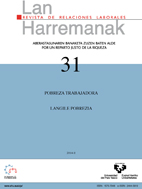Apuntes sobre la incidencia de la pobreza relativa y absoluta en la población y en los trabajadores. Comparación entre 2009 y 2013
##plugins.themes.bootstrap3.article.main##
##plugins.themes.bootstrap3.article.sidebar##
Abstract
This paper shows the current poverty rate (relative and absolute) and how far different features (personal, coexistence and employment) are associated with this situation. Furthermore, it considers the influence of the economic crisis (2009-2013) in a possible change in the relative importance of these features. To do this, relative and absolute poverty rates in Spain are analysed using two Eurostat indicators: risk of poverty and severe material deprivation, through the Survey on Living Conditions (ECV) by the Spanish statistical body INE. The results show it is useful to use both indicators, as the general rate of risk of poverty is not affected by the crisis (because the average income of Spanish households fell and with it the poverty threshold), so it is appropriate to qualify its results with material deprivation. Moreover, this superficial description includes the two factors associated with poverty as already discussed in specialist literature in Spain: the presence of minors in the household and its low work intensity. It also shows that the groups most affected by the current economic crisis are the unemployed, followed by young people.
How to Cite
##plugins.themes.bootstrap3.article.details##
Authors who publish in the journal "Lan Harremanak" do so in agreement with the following terms:
1. Authors retain the copyright of their papers. while ceding to the journal "Lan Harremanak" the right to the first publication of their article.
2. The publisher UPV/EHU Press is a joint copyright holder, in order to protect the legitimate use of the published paper and compliance with CC terms.
3. Published papers are subject to a Creative Commons CC-BY license (unless stated otherwise) which permits third parties to share the paper, on the condition that the author and source are specified when material is reproduced.
4. Authors can enter into other non-exclusive license agreements regarding the published version of their work (e.g. depositing it in an institutional repository or re-publishing it as a monographic volume), providing the author and source are given appropriate credit.
5. Dissemination of submitted articles via Internet is both allowed and recommended (e.g. in institutional repositories and/or on the researcher's web page), both before and during the process of submission, since this can lead to interesting dialogues and also increase citations to the eventual publication.

